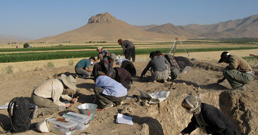Roger Matthews*
The Central Zagros of west Iran is of great importance in a major episode of transformation in human history: the change from mobile hunting and gathering to sedentary agriculture and animal husbandry after the end of the Ice Age 12,000 years ago. The Zagros is a key heartland of wild animals and plants that were later domesticated. The Central Zagros Archaeological Project (CZAP) is a new programme of Iran-UK research, investigating origins of sedentism, domestication, and agriculture in western Iran. Phase One aims to investigate two Pre-Pottery Neolithic sites in the lower and higher Central Zagros. The site of Sheikh-e Abad (Sheikhiabad) is in the upland cooler Zagros in a fertile plain with 3000m-high peaks. Jani lies close to the foothills of the Mesopotamian plains in the lower, warmer Zagros in valleys with 1500m-high ridges. Each site comprises 8-10m of occupation deposits covering one hectare.
The importance of these sites lies in their early date and long occupation spanning 9,800-7,600 BC, and in their location on the most important route-way through the Zagros, later the Silk Road.
Excavations at Sheikh-e Abad
Sheikh-e Abad lies northeast of Kermanshah. It is almost entirely a Pre-Pottery Neolithic mound. Trench 1 at the base of the mound investigated earliest levels of ashy midden. A radiocarbon date gives 9810 BC, making Sheikh-e Abad the earliest Neolithic site yet found in Iran and one of the earliest in Southwest Asia. In Trench 2 we excavated 2.5m of ash layers related to food preparation, rich in charred plant remains.
In Trench 3 we exposed an area of 118m2, revealing two buildings. Building 1 comprises small rooms and ash deposits in a courtyard, rich in animal bones and plant remains. Cut into these rooms six Neolithic human burials were excavated, one with red ochre adornment.
Building 2 comprises a T-shaped room. At the south end we excavated an extraordinary range of items that suggest the room was a shrine. The deposit included four skulls of large wild goats with pairs of horns. The skull on the east front side had red ochre applied to its cheek and upper teeth. Behind the four wild goat skulls the skull and horns of a large wild sheep had been placed. The Sheikh-e Abad shrine provides evidence for cult activities contemporary with early goat management and domestication c. 10,000 years ago. Building 2 is dated to 7590 BC.
Investigations at Jani
Jani lies in the lower, warmer Zagros southwest of Kermanshah, 90km from Sheikh-e Abad. Investigations focused on a 60m-long section cut by a river, which provides a unique insight into the interior of a Pre-Pottery Neolithic mound. We cleaned, drew, photographed, and took samples, including for micromorphological analysis.
Preliminary study of the lithics, animal bones, and charred plant remains from Jani indicates strong comparison with Sheikh-e Abad, supported by a date of 8140 BC.
Summary
At Sheikh-e Abad and Jani we have substantial long-lasting settlements of the Pre-Pottery Neolithic, with varied subsistence practices but including an emphasis on hunting wild goat and sheep. Analysis has identified herbivore dung in many deposits, suggesting there was proximity to animals, possibly early herd management. The use of wild goat and sheep skulls in cultic practices in Building 2 indicates that these animals had a significance beyond economic.
There is no indication that people at either site engaged in agriculture, especially involving cereals, but they exploited many of the plants available in the surrounding landscape, including lentils, pistachio and almond. Sheikh-e Abad and Jani were inhabited by hunter-foragers rather than farmers, with indications of early animal management. Our excavations here illuminate one pathway in the Early Neolithic taken by human communities of the Fertile Crescent in the millennia after the end of the last Ice Age, with subsistence based on intensified exploitation of wild plants and animals.
*Roger Matthews is a Professor of Near Eastern Archaeology at the University of Reading and co-director of the Central Zagros Archaeological Project. The project is a joint Iran-UK research programme involving teams of archaeologists from Bu-Ali Sina University in Hamedan and Tehran University.
The proposed temporal scheme of Western Iran based on the latest findings


